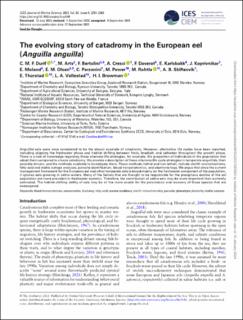| dc.contributor.author | Durif, Caroline | |
| dc.contributor.author | Arts, M. | |
| dc.contributor.author | Bertolini, F. | |
| dc.contributor.author | Cresci, Alessandro | |
| dc.contributor.author | Daverat, F. | |
| dc.contributor.author | Karlsbakk, Egil Erlingsson | |
| dc.contributor.author | Koprivnikar, J. | |
| dc.contributor.author | Moland, Even | |
| dc.contributor.author | Olsen, Esben Moland | |
| dc.contributor.author | Parzanini, C. | |
| dc.contributor.author | Power, M. | |
| dc.contributor.author | Rohtla, Mehis | |
| dc.contributor.author | Skiftesvik, Anne Berit | |
| dc.contributor.author | Thorstad, Eva Bonsak | |
| dc.contributor.author | Vøllestad, Leif Asbjørn | |
| dc.contributor.author | Browman, Howard | |
| dc.date.accessioned | 2024-01-16T09:17:24Z | |
| dc.date.available | 2024-01-16T09:17:24Z | |
| dc.date.created | 2024-01-02T13:00:59Z | |
| dc.date.issued | 2023 | |
| dc.identifier.citation | ICES Journal of Marine Science. 2023, 80 (9), 2253-2265. | |
| dc.identifier.issn | 1054-3139 | |
| dc.identifier.uri | https://hdl.handle.net/11250/3111678 | |
| dc.description.abstract | Anguillid eels were once considered to be the classic example of catadromy. However, alternative life cycles have been reported, including skipping the freshwater phase and habitat shifting between fresh, brackish, and saltwater throughout the growth phase. There is a lack of knowledge regarding these alternate life strategies, for example, the proportion of individuals in the population that adopt them compared to classic catadromy. We provide a description of these alternate life cycle strategies in temperate anguillids, their possible drivers, and the methods available to investigate them. These methods (lethal and non-lethal), include otolith microchemistry, fatty acid and stable isotope analyses, parasite identification, blood transcriptomics, and electronic tags. We argue that since the current management framework for the European eel and other temperate eels is based mainly on the freshwater component of the population, it ignores eels growing in saline waters. Many of the factors that are thought to be responsible for the precipitous decline of the eel population are more prevalent in freshwater systems. Therefore, the contribution of saline eels may be more important than currently estimated. The habitat-shifting ability of eels may be all the more crucial for the persistence and recovery of those species that are endangered. | |
| dc.language.iso | eng | |
| dc.title | The evolving story of catadromy in the European eel (Anguilla anguilla) | |
| dc.title.alternative | The evolving story of catadromy in the European eel (Anguilla anguilla) | |
| dc.type | Peer reviewed | |
| dc.type | Journal article | |
| dc.description.version | publishedVersion | |
| dc.description.version | publishedVersion | |
| dc.source.pagenumber | 2253-2265 | |
| dc.source.volume | 80 | |
| dc.source.journal | ICES Journal of Marine Science | |
| dc.source.issue | 9 | |
| dc.identifier.doi | 10.1093/icesjms/fsad149 | |
| dc.identifier.cristin | 2218930 | |
| dc.relation.project | Norges forskningsråd: 280658 | |
| cristin.ispublished | true | |
| cristin.fulltext | original | |
| cristin.fulltext | original | |
| cristin.qualitycode | 2 | |
